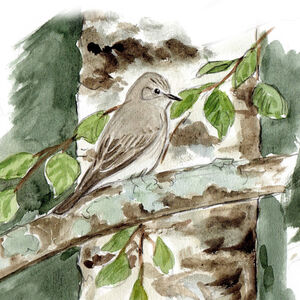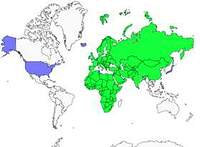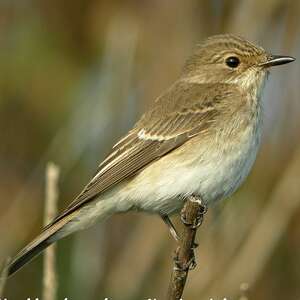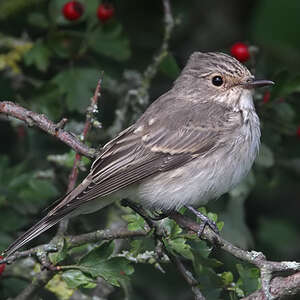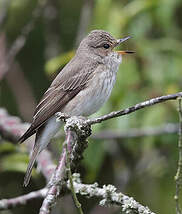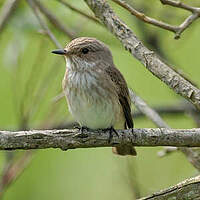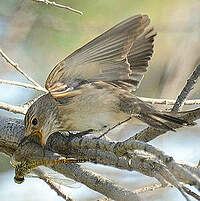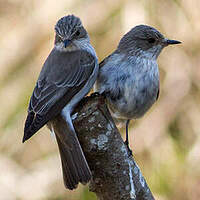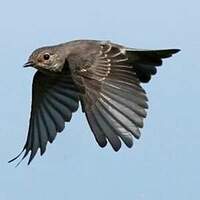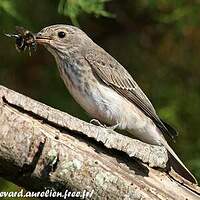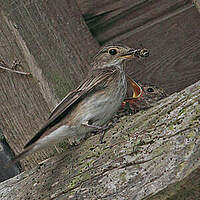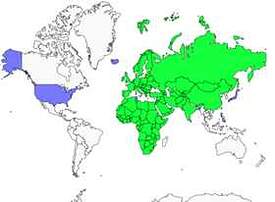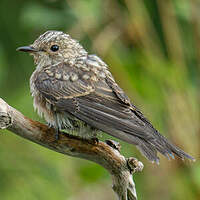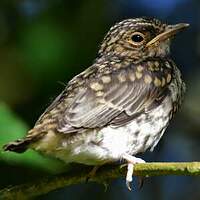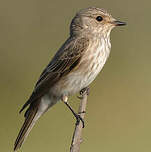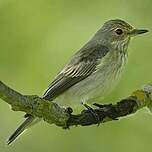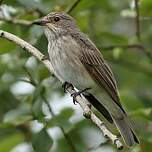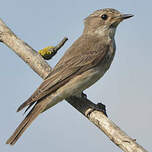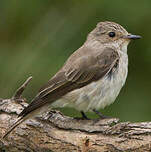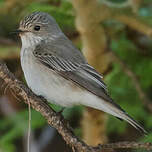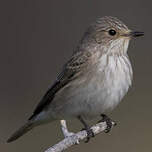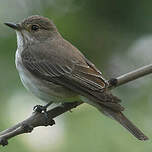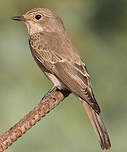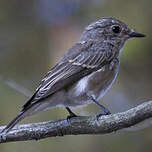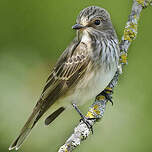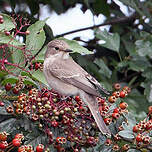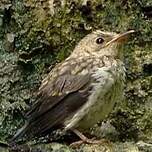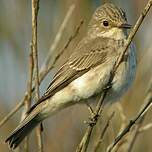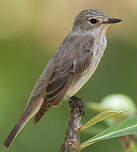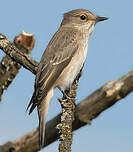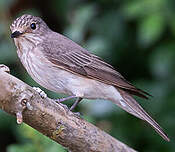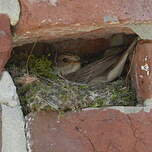Spotted Flycatcher
Muscicapa striata - Gobemouche gris
Identification
The Spotted Flycatcher has very discreet and plain plumage. The upperparts are a uniform, brown-grey color on the mantle. The wings, with their long primary projection, are dark brown and contrast with their coverts, coloured like the mantle and edged in whitish, like the tertiaries. The head is distinguished by a streaked brown crown, a big dark eye that stands out on the uniform lore-parotid, a wide beak with a yellow base in the lower mandible, and lastly a slightly streaked throat with a more or less strong brown malar streak according to the individual. The underside is whitish, washed in russet on the flanks. The chest is clearly marked with thin brown streaks, visible only up close and which gave it its specifig name striata. The undertail is the whitest part of the body. The tail is the same colour as the wings. The small feet are black. The juvenile, like most young muscicapidae when they leave the nest, have a distinctly spotted plumage, here light above and scaled below; however this plumage is fleeting and replaced at the following post-juvenile molt with one very similar to the adult one but with an russet tone around the eye and on the undertail, and a clear bar at the end of the large wing coverts. The subspecies balearica (Balearic Islands) is paler and less streaked than the nominate subspecies, and the subspecies tyrrhenica (Corsica and Sardinia) is of a warmer brown on the top and also less streaked on the bottom. A recent study (Pons et al. 2015) shows that these two subspecies are genetically distinct enough from the nominate subspecies to be considered as subspecies of a separate species which the authors propose to call Muscicapa tyrrhenica.But this distinction has not yet been approved by the relevant authorities.
Subspecific information 5 subspecies
- Muscicapa striata striata (Europe to w Siberia, nw Africa)
- Muscicapa striata inexpectata (Crimea. s Ukraine.)
- Muscicapa striata neumanni (islands of the Aegean Sea through the Middle East to the Caucasus and n Iran, also c Siberia)
- Muscicapa striata sarudnyi (e Iran and Turkmenistan to the mountains of c Asia and n Pakistan)
- Muscicapa striata mongola (Mongolia and sc Siberia)
Foreign names
- Gobemouche gris,
- Papamoscas gris,
- taralhão-cinzento,
- Grauschnäpper,
- szürke légykapó,
- Grauwe Vliegenvanger,
- Pigliamosche,
- grå flugsnappare,
- Gråfluesnapper,
- muchár sivý,
- lejsek šedý,
- Grå Fluesnapper,
- harmaasieppo,
- Europese Vlieëvanger,
- papamosques gris,
- Grágrípur,
- muchołówka szara,
- pelēkais mušķērājs,
- sivi muhar,
- Серая мухоловка,
- ムナフヒタキ,
- 斑鹟,
- grå flugsnappare,
- 斑鶲,
Voice song and call
The Spotted Flycatcher doesn't stand out with its voice in its arboreal habitat either. It takes a trained ear to discern its song or its cries from the other vocal emissions in the chorus which characterizes the forest environment in spring. Its song, very little developed, is a tranquil succession of high notes with a slightly rough tone, "tsiii tsrii", with little variation in tonality or rhythm. The cries are very much like the singing strophes for a human ear. The alarm call is a typical "eight tit", which is repeated with an ever-increasing frequency depending on the danger. The juveniles beg for their food with a rolling "pinson" cry.
Habitat
The Spotted Flycatcher is primarily a forest bird. It can be found in both deciduous and coniferous or mixed vegetation.
Behaviour character trait
The Spotted Flycatcher is an tireless insect hunter and has typical behaviour whereby it stands proudly on a perch (branch, wire, etc.
It often remains motionless on a low thick branch and then suddenly takes off with a rapid flight to catch an insect in the air, in a tree or on the ground. It often flaps its tail and wings. It is a strict migrator, arriving late in Europe, not before May (as early as March in Corsica) and migrating birds are still present at the end of this month, even early June, in Mediterranean regions. Post-nuptial movements are at their maximum during September. The Spotted Flycatcher's wintering area spreads out over all of Africa south of Saharan regions, with the easternmost populations wintering further south.Flight
The flight of the Spotted Flycatcher is direct and swift due to its long wings of a migrant bird. This easy flight allows it to quickly reach in flight from a perch big flying insects, like Syrphid flies and skylarks, which it feeds on, and quickly return to its initial perch or another one. It is also capable of making short, hovering flights.
Dietfeeding habits
He mostly feeds on flying insects, particularly diptera and hymenoptera, but also butterflies, bugs, dragonflies, etc. His diet can be quite varied depending on the resource and he can sample most invertebrate groups. He is also drawn to small fruits when the opportunity presents itself, especially during migration.
Reproduction nesting
The female Spotted Flycatcher builds a light cup, made of moss, threads, licheng and lined with horsehair, wool or feathers. It is built in vegetation or in a cavity. She lays in May/June of 4 or 5 greenish or bluish eggs speckled with brown-red. The incubation lasts about 13 days and is maintained only by the female. Both parents feed the chicks for 15 days until they acquire their definitive plumage. Both adults take care of the young ones for 15 days.
Geographic range
The species is widespread during the breeding season, from the Atlantic to Central Siberia and Mongolia, from the north of Scandinavia to the Maghreb and the Middle East to the south. Its presence matches that of the forests. It is absent from the deserts of Central Asia. The species can be locally very common, like in Scandinavia, or rather rare, like in south-eastern France. The wintering range of this long-distance migrant is in Africa, south of a line from Senegal to Kenya. It frequents various forest and savannah habitats there.
Threats - protection
IUCN conservation status
concern
in the Wild
threatened
evaluated
The population of the Spotted Flycatcher is declining across Europe due to the extensive use of agricultural pesticides, deforestation, reduction of tree age at harvesting, and degradation of winter habitats. This species should be closely monitored in France.
Sources of information
- IOC World Bird List (v15.1), Gill, F and D Donsker (Eds). 2025-12-07.
- Revue Journal of avian biology, N° 46, J.-M. Pons , J.-C. Thibault , R. Aym í , M. Grussu , J. Muntaner , G. Olioso , J. R. Sunyer , M. Touihri and J. Fuchs
- HBW Alive,
- Nouvel inventaire des oiseaux de France, Philippe J. Dubois, Pierre Le Maréchal, Georges Olioso, Pierre Yésou
Other sources of interest
 Specification sheet created on
19/07/2023 by Jean François
Specification sheet created on
19/07/2023 by Jean FrançoisTranslation by AI Oiseaux.net
© 1996-2025 Oiseaux.net
- Accipitriformes
- Aegotheliformes
- Anseriformes
- Apodiformes
- Apterygiformes
- Bucerotiformes
- Caprimulgiformes
- Cariamiformes
- Casuariiformes
- Charadriiformes
- Ciconiiformes
- Coliiformes
- Columbiformes
- Coraciiformes
- Cuculiformes
- Eurypygiformes
- Falconiformes
- Galliformes
- Gaviiformes
- Gruiformes
- Leptosomiformes
- Mesitornithiformes
- Musophagiformes
- Nyctibiiformes
- Opisthocomiformes
- Otidiformes
- Passeriformes
- Pelecaniformes
- Phaethontiformes
- Phoenicopteriformes
- Piciformes
- Podargiformes
- Podicipediformes
- Procellariiformes
- Psittaciformes
- Pterocliformes
- Rheiformes
- Sphenisciformes
- Steatornithiformes
- Strigiformes
- Struthioniformes
- Suliformes
- Tinamiformes
- Trogoniformes

